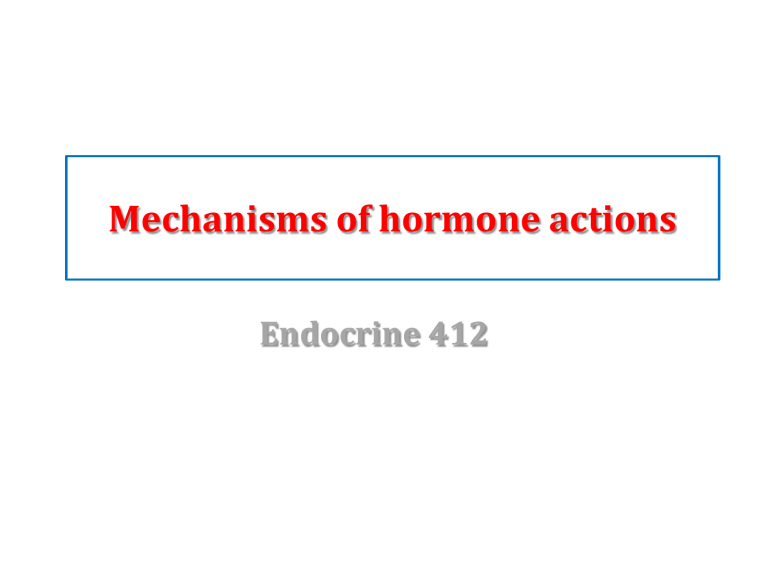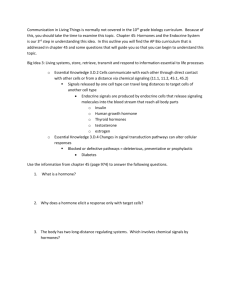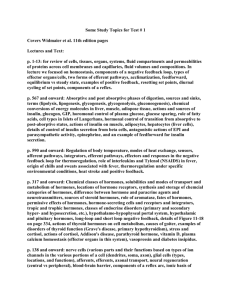hormones

Mechanisms of hormone actions
Endocrine 412
Objectives
• Defining hormones and their classifications.
• Listing the general characteristics of hormones.
• Identifying factors determining the response of target cells to hormones.
• Describing the different mechanisms of action of hormones.
• Listing hormones that bind to cell surface receptors.
• Listing hormones that bind to intracellular receptors.
General characteristics of hormones
Hormones :
• are molecules that are produced by special cells (not by all cells of the body)
• are secreted directly to blood (with no ducts)
• are available in very low concentrations in blood
• are transported in blood to work in distant sites
• have systemic actions
• have specific receptors (either intra- or extra-cellular ) in target tissues
• have different special mechanisms of actions
Receptors of hormones
• Hormones are present in very low concentrations in extracellular fluids (e.g. blood)
• In order to initiate their biologic effects, target cells must recognize hormones by binding to specific receptors
• A target cell is defined by its ability to bind selectively a given hormone via a receptor
• Receptors have at least 2 DOMAINS:
1- Recognition domain: binds to the hormone
2- Coupling domain: couples hormone recognition to some intracellular function by generating a signal
Generally, COUPLING occurs by two ways:
1- Polypeptide hormones, protein hormones & catecholamines binding of hormones to plasma membrane receptors (extracellular receptors).
2- Steroid & thyroid hormones interact with intracellular receptors, form complexes that generates a signal.
The concentration of hormone as seen by target cells is determined by three factors:
1-Rate of production:
Synthesis and secretion of hormones are the most highly regulated aspect of endocrine control. Such control is mediated by positive and negative feedback circuits
The concentration of hormone as seen by target cells is determined by three factors:
(cont.)
2-Rate of delivery:
An example of this effect is blood flow to a target organ or group of target cells – high blood flow delivers more hormone than low blood flow.
3-Rate of degradation and elimination:
Hormones, like all biomolecules, have characteristic rates of decay, and are metabolized and excreted from the body through several routes.
Hormones are cleared by:
1- Metabolic destruction by tissues
2- Binding with tissues
3- Excretion by the liver into bile
4- Excretion by the kidney into urine
5- Clearance of protein bound hormones is slower than clearance of peptide hormones
Classifications of hormones
• Hormones are classified according to:
1- Chemical composition (protein or others)
2- Solubility (hydrophilic or lipophilic)
3- Location of receptors (intra- or extra-cellular)
4- Nature of signal used to mediate hormone action within cells
According to classifications 3 & 4, hormones are classified into
Group I & Group II
( according to mechanism of action )
Classification of hormones according to mechanism of action:
Group I
Hormones that bind to intracellular receptors (cytosolic or nucleus):
1- Solubility: lipophilic (to pass cell membrane which is mainly lipid)
2- Chemical composition:
Derived from cholesterol (except: thyroid hormones & retinoic acid)
3- Transport in blood:
Associate with transport proteins (to tackle solubility problem)
Long plasma half-life
5-Mechanism of action:
1- Free hormone traverses plasma membrane of cells & binds to receptor in cytosol or nucleus of target cells.
2- Hormone-receptor complex binds to specific region in DNA of gene (hormone-response element,
HRE)
3- Binding causes activation or inactivation of specific gene(s) transcription (production of mRNA)
4- Accordingly, amount of protein synthesis (production) is changed (protein may be enzymes of metabolic react.)
5- Accordingly, certain metabolic processes are affected.
Example of Group I hormones:
Steroid hormones
Cytosolic
Receptors
Example of Group I hormones:
Retinoic acid
(active product of vitamin A)
Nuclear
Receptors
List of Group I hormones
• Thyroid hormones
• Steroid hormones:
Glucocorticoids (e.g. cortisol hormone)
Mineralocorticoids (e.g. aldesterone)
Androgens (e.g. testosterone hormone)
Estrogens
Progestins (e.g. progesterone hormone)
• Retinoic acid (active metabolite of vitamin A)
• Calcitriol (1, 25 DHCC, active metabolite of vitamin D)
Classification of hormones according to mechanism of action:
Group II
Hormones that bind to plasma membrane (extra-cellular) receptors:
1- Solubility: hydrophilic
2- Chemical composition:
Polypeptides, proteins, glycoproteins & catecholamines
3- Transport in blood: No transport protein- short plasma half-life
5-Mechanism of action:
Hormone binds to plasma membrane receptor
Hormone -receptor interaction leads to generation of second messenger intracellularly that communicates (couples) hormones binding with intracellular metabolic processes
Second messengers:
1- cyclic AMP (cAMP)
2- cyclic GMP (cGMP)
3- Calcium or phosphaitdyl inosiltol (or both)
4- Kinase cascade
Second Messenger: cAMP
List of Group II hormones
1- Second messenger is cAMP: a 2 & b adrenergic Catecholamines
Adrenocorticotropic Hormone (ACTH)
Angiotensin II
Antidiuretic Hormone (ADH)
Calcitonin
Human Chorionic Gonadotropins (hCG)
Corticotropin-releasing hormone (CRH)
Follicle Stimulating Hormone (FSH)
Leutinizing Hormone (LH)
Glucagon
Ipotropin (LPH)
MSH (Melanocyte Stimulating Hormone)
Parathyroid Hormone (PTH)
Somatostatin
Thyroid Stimulating Hormone (TSH)
List of Group II hormones
1- Second messenger is cGMP
Atrial natriuretic peptide (ANP)
Nitric Oxide (NO)
There are two isoforms of guanylate cyclase involved in production of cGMP:
• A membrane-bound guanylate cyclase ( for ANP & bacterial endotoxin)
• A cytosolic guanylate cyclase (for NO)
Second messenger cGMP:
Atrial Natriuretic Peptide
GC: Gunaylate cyclase
NO• signaling in physiology
O
2
•
N itric O xide S ynthase
NO •
ONOO-
Binds to heme moiety of guanylate cyclase
Conformational change of the enzyme
Increased activity
(production of cGMP)
Modulation of activity of other proteins (protein kinases, phosphodiesterases, ion channels)
Physiological response
(relaxation of smooth muscles, inhibition of platelet aggregation, etc.)
Second Messenger: Phosphatidyl inositol &
calcium
List of Group II hormones
1- Second messenger is phosphatidyl inositol or calcium
(or both together)
Acetylcholine a 1 adrenergic catecholamines
Angiotensin II
Antideuretic Hormone (ADH)
Cholecystokinin
Gastrin
Gonadotropin –Releasing Hormone (GnRH)
Oxytocin
Platelet Derived Growth Factor (PDGF)
Substance P
Thyrotropin Releasing Hormone (TRH)
Second Messenger: Kinase cascade
(for insulin hormone)
Binding of insulin on a -subunits
Of insulin receptors
Phosphorylation of b -subunits
Of insulin receptors
Phosphorylation of insulin response substrates (IRS)
CHANGE
IN
Gene Metabolism Growth
Expression
List of Group II hormones
1- Second messenger is kinase cascade:
Chorionic somatomammotropin (CS)
Epidermal Growth factor (EGF)
Erythropoeitin (EPO)
Antideuretic Hormone (ADH)
Fibroblast Growth Factors (FGF)
Growth Hormone (GH)
Insulin
Insulin-like Growth factors (IGF-I & IGF-II)
Nerve Growth Factor (NGF)
Platelet Derived Growth Factor (PDGF)
Prolactin (PRL)









